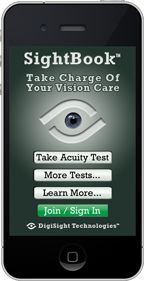It’s true that your smartphone can cause eye strain and bad posture, but did you know that your smartphone can also help you more easily connect with health care professionals, care for your vision, and even provide preliminary diagnoses of eye conditions? Here are five ways your smartphone can change your eye health for the better.
1. Make Reading Easier
You probably know that the brightness and font size on your smartphone can be adjusted to make reading easier. In fact, a recent study, on electronic screens and low vision, showed that back-lit screens and font enlargement can restore reading ease to individuals with loss of central vision due to conditions like diabetic retinopathy.
But, your smartphone can also help with reading traditional materials, like restaurant menus and medication warnings. There are apps available for both Apple and Android products that magnify through your device’s camera and can use your smartphone’s flash to provide extra light.
2. Provide Direct Access to Physicians
From mobile email to FaceTime access in the palm of your hand, smartphones make connecting easy. There are myriad apps that provide a direct link to your health care providers and help them more easily deliver the best care. Some of these apps include:
- PocketPharmacist provides a virtual “pillbox,” which automatically checks for any concerning interactions between medications. This list can then be sent straight to your doctor or optometrist to help them decide which medication options work best with what you are already taking.
- Lenstoss is a contact lens care calendar which reminds you to get rid of your old contacts and automatically emails your doctor when you need to order new lens.
- American Well lets you video chat with a doctor. These licensed physicians can answer questions, diagnose conditions, and even prescribe medication. Check with your health insurance provider to find out if you have telehealth coverage.
3. Monitor Changes in Your Eyesight
 Whether you have been diagnosed with a fast-changing eye condition like macular degeneration or simply want to check if you need a new eye glasses prescription, there are now apps that allow you to test your eyesight wherever you are. Apps like Sightbook administer visual acuity tests and send your results straight to your eye care provider.
Whether you have been diagnosed with a fast-changing eye condition like macular degeneration or simply want to check if you need a new eye glasses prescription, there are now apps that allow you to test your eyesight wherever you are. Apps like Sightbook administer visual acuity tests and send your results straight to your eye care provider.
Be sure to follow up with your optometrists when using this kind of app. Smartphone eyesight monitoring apps are a great general test system, but they can’t replace eye health care professionals like those at Crowfoot Vision Center.
4. Test for Common Eye Conditions
The preliminary tests for many serious eye conditions, such as Age-Related Macular Degeneration or AMD, are fairly simple. Most involve monitoring where loss of sight occurs in the field of vision. Now, there’s an app for that.
There are several apps available that use an Amsler Grid test, a testing method for tracking AMD, and record the changes in image distortion so you can show them to your eye doctor. Other apps like provide patient history surveys that can aid in diagnosing glaucoma, color blindness tests, astigmatism tests, and more.
5. Provide Patient Education
Your smartphone can be a gateway to lots of information about your health. Using apps like EyeHandbook, you can learn more about the anatomy of your eyes, common eye conditions, and the best ways to care for your optical health.
Talk to your eye doctor about which apps will be most helpful in maintaining and monitoring your eye health.









Comments